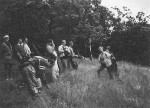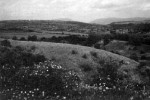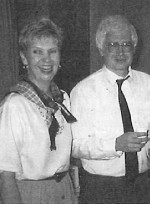Identifying a research basis and sites, scientists and databases for collaboration
LTER scientists visited the range of ecosystem types that exist within the country, from dry, sandy grasslands to wet, loess grasslands to temperate forests and lakes
A part of a National Science Foundation (NSF) International Program grant funded to Diana Freckman (McMurdo LTER) and Debra Coffin (Central Plains LTER) at Colorado State University, ten LTER scientists visited the Hungarian Nature Reserves May22 to 29, 1994. The visit and grant arc part of an exchange begun with a 1993 visit to Hungary by NSF Division of Environmental Biology Director James Gosz and Sevilleta data management specialist James Brunt (see Network News Issue #15, 1994).
Objectives
The objective of the grant is to promote the exchange of knowledge on biodiversity research between Hungarian scientists, who are world leaders in conducting biological surveys, and U.S. scientists, who are among the world leaders in ecosystems research. Three meetings are planned in 1994-95 as part of the collaboration. Dr. Edit Kovács-Láng, Hungarian Academy of Sciences Institute of Ecology and Botany, is organizing participating Hungarian scientists from the Balatón Limnological Institute, Eotvos Lorand University, the Institute of Soil Science and Agricultural Chemistry, the Hungarian Natural History Museum, and the Plant Protection Institute.
The purposes of the nine-day trip to Hungary in May were to identify:
- A research basis for collaboration
- Potential sites and scientists for collaborative partnerships
- Long-term biological survey databases that would be useful for comparison with U.S. LTER databases.
LTER participants included:
- Linda Blum and Bruce Hayden (Virginia Coast LTER)
- Jack Lattin and Tim Schowalter (H.J. Andrews LTER)
- John Magnuson (North Temperate Lakes LTER)
- Bob Parmenter and Terry Yates (Sevilleta LTER)
- Bob Waide (Luquillo LTER)
- Freckman and Coffin
Over 20 Hungarian scientists participated.
Datasets, Climatic Types & Ecosystems
LTER participants were impressed with the quality and quantity of data on biodiversity collected in the past and currently being collected by Hungarian scientists. Some climate and terrestrial and aquatic taxonomic datasets date from the late 1800s. Hungary has three climatic types (humid atlantic, dry continental, and mild submediterranean) that, along with the topography, contribute to produce an ecologically interesting aridity gradient for soils and vegetation over relatively short distances. The LTER scientists visited the range of ecosystem types that exist within the country, from dry, sandy grasslands to wet bess grasslands to temperate forests and lakes.
One site the group visited was Kiskunsagi National Park, the 30,000-hectare site of an all-taxa survey, which is a good example of a mosaic of ecosystems, each influenced by land management practices:
- Marsh
- Meadow
- Steppe
- Forest
- Agricultural field
- Saline lake
Organisms within the Park have been identified and results published in two volumes each on the flora and fauna. The fauna includes vertebrates (and their parasites) and soil invertebrates, such as tardigrades and nematodes.
A comparison of Potential Areas for Collaboration
A comparison of various community- structure datasets would be productive far both U.S. and Hungarian scientists
Since Eastern Europe has comparable ecosystems to North America, a comparison of various community- structure datasets (biodiversity, trophic analyses, etc.) would be productive for both U.S. and Hungarian scientists. Datasets of different taxonomic resolution could be examined in terms of landscape-level changes, stability of foodweb structures in disturbed ecosystems, socioeconomic issues, and effects of land-use management and climate. The collaboration promises to provide critical information on biodiversity that will enhance and strengthen both research programs, expand on the use of both collections of datasets, and add to our collective knowledge of the relationships among species and ecosystems.
There are a number of potential long-term ecological research sites in Hungary, including national parks and biosphere reserves with lakes, streams and rivers which have a history of long-term biodiversity data collection. Areas of common interest with LTER sites include effects of land management and human use, grazing, fire, biomonitoring (short-term) versus trend monitoring (which species is selected for trend analysis), climate change and policy issues, and securing stable funding.
Recommendations
The LTER participants returned from Hungary enthusiastic about the possibilities for collaboration. Noting the strengths of the long-term datasets and the Hungarians’ desired focus on training in systematics and taxonomy, they recommended initiating the following activities as an aid to ongoing collaboration:
- Invite Hungarian scientists to attend workshops in the United States where topics include the long-term species database management, and the use of GIS and simulation modeling to analyze long-term data, in order to enhance understanding of the relationships between species diversity and ecosystem function.
- Establish a program for exchanges of graduate students and scientists between Hungary and the United States.
- Establish an electronic link between U.S. LTER and Hungarian scientists for the exchange of information on research programs, bibliographies and datasets, utilizing the LTER electronic information system. Bruce Hayden, Virginia Coast Reserve LTER site, is leading this effort with the assistance of LTER Network Office staff.
Further Activities
Following the U.S. LTER trip to Hungary, 16 Hungarian Scientists representing a wide range of specialties visited five LTER Sites (Kellogg, Sevilleta, Central Plains, Niwot, Andrews) in September 8-18, 1994 to discuss management, analysis and synthesis of long-term data.
The final meeting under the grant will be a workshop in February 1995 in Hungary to initiate and establish research collaborations in the areas of biodiversity and climate change.
Diana W Freckman, Natural Resource Ecology Laboratory and College of Natural Resources, Colorado State University, Fort Collins, CO 80523, 303-491-1982, 303-491-1965 (Fax), dfreckman@LTERnet.edu

 Enlarge this image
Enlarge this image


